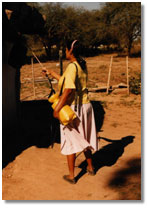 |
|
|
 |
||
| ||||||||||||||||||
|
Researchers' Mathematical Model Provides Chagas
Disease Insights
|
||||||||||||||||||
|
|
|
By characterizing the population dynamics of an individual household, and by collecting data for many individual households to serve as a base, a National Science Foundation (NSF)-funded researcher and his Argentinean colleague have identified improved control tactics for a vexing public health problem.
A mathematical model called a system of nonlinear difference equations indicates that the chronic, frequently fatal Chagas disease infection could be avoided or greatly reduced in humans in the Gran Chaco region of South America by barring domestic animals from bedrooms. Chagas disease, or American trypanosomiasis, is caused by infection with the protozoan parasite Trypanosoma cruzi and occurs predominantly in rural Latin America. Some cases have also been reported in the southern U.S.
"This study demonstrates how basic research in the mathematics of population dynamics, when combined with information on the natural history of a disease, can provide simple and inexpensive methods for disease prevention," says Samuel Scheiner, program director in NSF's division of environmental biology, which funded the research.
The research provides an immediate and practical defense against the disease, complementing the more commonly implemented insecticide spraying and housing improvement controls.
"The mathematical model is a way of putting together everything we know about household transmission of infection, to see how all the pieces of the puzzle affect the bottom line, human infection," says scientist Joel Cohen of The Rockefeller University and Columbia University's Earth Institute. "The model makes it possible to do, inside of a computer, experiments that we could not ethically do in a real household, such as hypothetically varying the number of infected dogs without trying to reduce the number of infected bugs. Our simple mathematics gives insight attainable no other way."
Reporting in the July 27 edition of Science, Cohen and Ricardo E. Gürtler of the University of Buenos Aires predicted how four populations-bugs, chickens, dogs and people-interact with T. cruzi each season in an individual household. The model was developed in close connection with data collected over ten years in three rural villages-Amama, Trinidad and Mercedes-in the Province of Santiago del Estero, Northwest Argentina. T. cruzi is spread through the feces of domestic blood-feeding bugs called triatomines, also known as "kissing bugs" (with local names such as "vinchuca," "chipo," or "barbeiro").
Domestic triatomine bug populations start to grow in Argentina during the spring. Part of the bug population growth is fueled by blood meals the bugs take from chickens, which during the spring are kept indoors to brood protected from theft or predation. Chickens cannot be infected with T. cruzi whereas dogs and humans can be. But the infected dogs are much more infectious to the bugs than the infected humans, and therefore fuel population growth of both bugs and T. cruzi.
By the time the chickens roost outdoors in the summer, the already large domestic bug population shifts to feed preferably on dogs and secondarily on humans, which rapidly spreads the prevalence of T. cruzi among bugs. This in turn increases the infection rate among dogs and humans.
Because triatomine bugs are more likely to feed on chickens and dogs than on humans, summer infection rates grow for humans as people share domestic sleeping quarters with infected dogs.
The mathematical model provides thirteen predictions about the transmission of T. cruzi. Two of them greatly affect human health:
- keeping dogs in the bedroom is "the worst
thing householders can do," with respect to Chagas
disease;
- and exclusion of infected dogs from sleeping areas will virtually eliminate transmission of the parasite, at least in semi-arid settings like those studied in the Gran Chaco region.
This research was also supported by the Rockefeller Foundation, Universidad de Buenos Aires, the Fulbright and Thalmann programs, and CONICET of Argentina.
![]()
NSF is an independent federal agency which supports fundamental research and education across all fields of science and engineering, with an annual budget of about $4.5 billion. NSF funds reach all 50 states, through grants to about 1,800 universities and institutions nationwide. Each year, NSF receives about 30,000 competitive requests for funding, and makes about 10,000 new funding awards.
Receive official NSF news electronically through the e-mail delivery system, NSFnews. To subscribe, send an e-mail message to listmanager@nsf.gov. In the body of the message, type "subscribe nsfnews" and then type your name. (Ex.: "subscribe nsfnews John Smith")
Receive NSF publications and reports through the email- and web-based alert service, Custom News. To subscribe, go to http://www.nsf.gov and click on "Custom News Service."
|
|



